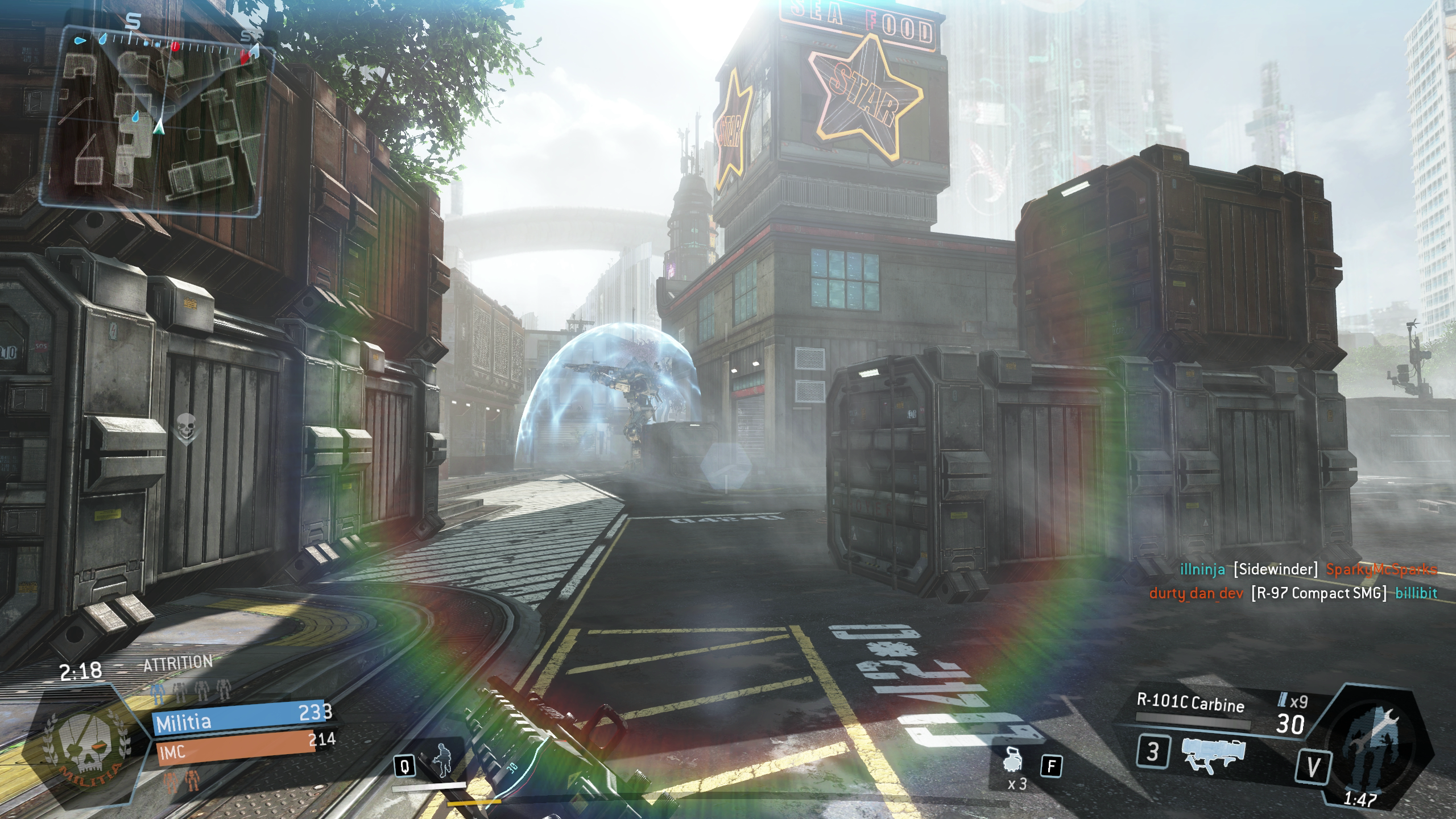Our Verdict
The most exciting multiplayer shooter in recent years, held back from greatness by its questionable staying power.
PC Gamer's got your back
Titanfall is the last place you'd expect to find restraint . This is a big money multiplayer shooter where robots called titans are summoned from space, where jetpack-equipped 'pilots' dash over, alongside and through sci-fi cityscapes. It's a game where you'll run up a wall, jet into the air, lock onto a platoon of grunts with your smart pistol and eliminate them all as you land. It's a game where you'll drop a 40-foot titan onto another 40-foot titan just to see if you can.
It's a game where you will do all of these things repeatably thanks to lean, intelligent multiplayer design. Matches are limited to 12 players split into two teams, and this restricted headcount is the foundation for all of Titanfall's other successes. Lower numbers enable the game to incorporate immediate respawns without upsetting its competitive balance, and an intelligent dynamic spawn system means that when you die you pop back near-instantly a short distance from the next big fight. The game ensures that you are doing something exciting for the entire duration of each ten- to fifteen-minute match.
Titanfall's other features provide plenty of strategic options, but its manageable scope means that you always have the opportunity to use them. This is what the latter Battlefield games got wrong. It's great to offer the player interesting objectives, vehicles or weapons, but they mean less if that player spends their time queueing, respawning or running to get to the next firefight. Titanfall never wastes your time. You always have the option to go and do something more exciting, to play better, or to try to generate another of the 'you had to be there' stories that the game excels at.
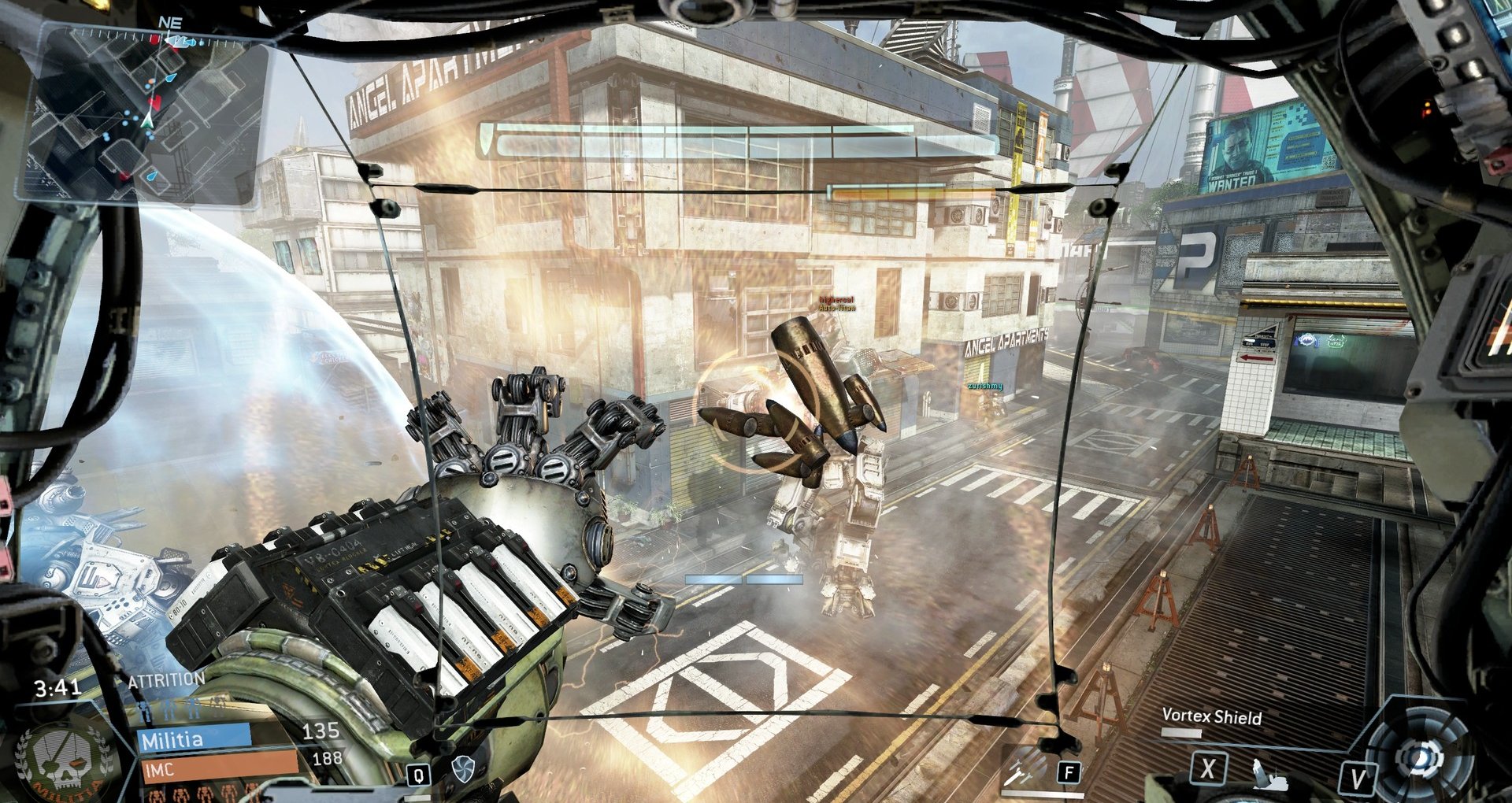
Here's a story, then. It's the closing minutes of a capture the flag match, and my team has a single point advantage - but the enemy has our flag. We're playing on Boneyard, a winding series of desert canyons where small military bunkers are linked by aerial ziplines. I sprint out of our base and, jetting into the air, use a bunker wall to pick up some momentum. I fling myself off, grab a zipline, and gain more speed: then I'm across a rooftop, through a short passageway, and up off the top of a defensive tower to ensure that I come down on the enemy base from above. Three enemy titans prowl the open area outside. Two are 'auto-titans', meaning that they are being controlled by the AI while their pilots are elsewhere. The third is manned. I activate my cloaking device to slip by them.
The moment I touch the flag, I'm highlighted on the HUD of every player on the map. I glance at my own titanfall timer. Thirty seconds to go. There are NPC soldiers in the enemy base, and each one felled cuts a few seconds off my titanfall timer. I stop, crouch, and kill a few more before rushing towards the precipitous drop to the desert floor. Leaping from the enemy base, I jump onto the roof of the manned enemy titan and unload half a clip into its innards. It's not enough to disable it, but it's enough to make the pilot disembark to try to dislodge me. By that point I'm away, jetting onto the next titan, buying myself the seconds I need to...
My titanfall timer hits zero. I aim at a point on the ground in the midst of the enemy titans and hit the 'V' key.
Keep up to date with the most important stories and the best deals, as picked by the PC Gamer team.
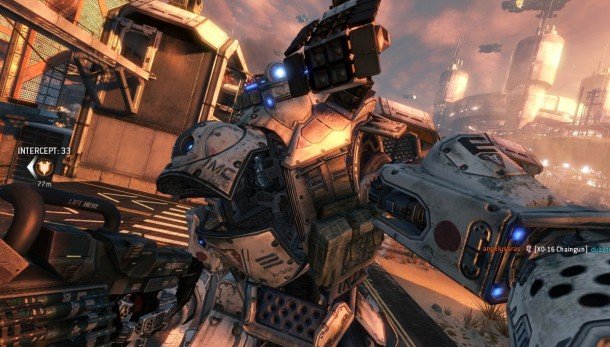
My Ogre titan smacks into the ground on all fours, hunched like a silverback. I leap towards it and it holds out its arm to help me climb inside. As its interface comes online, I'm already hammering the key to deploy electrified smoke. Then, in the midst of the chaos, I'm away, thundering across the desert towards our base, carrying the enemy flag towards the line of friendly titans that stride out to meet me. It feels incredible.
This series of moments is useful because it highlights how Titanfall's best qualities come from lots of individually well-designed parts operating together. As a footsoldier you always have access to a broad range of movement abilities that turn you into a cross between TF2's Scout and Tribes: Ascend's Pathfinder. You can double jump, zipline and wallrun at will, and with a bit of time you start to learn how these can be used in tandem. Wallrunning, for example, speeds you up - it's by chaining together wallruns without stopping that you build up titan-beating momentum. In the same way that a good Tribes player learns to see each hill as component parts of a longer route, so do Titanfall's city blocks eventually start to look like inviting, freeform obstacle courses.
How you choose to use your special abilities alongside your mobility is up to you. You might be a sniper who uses freerunning and a cloaking device to escape when your vantage point is discovered, or a close-quarters brawler who uses stims for a speed and health boost between firefights. You might spec for covert ops but swap out the cloaking device for a special vision mode that lets you see enemies through walls.
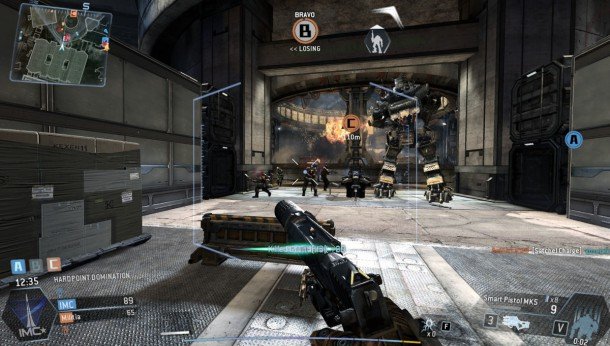
In each case you'll also be making decisions about whether to hunt other players or stop to kill the platoons of NPC minions that spawn throughout each match. Doing the latter might reveal your position on the minimap, but it'll also shave seconds off your titanfall timer. At first, the presence of AI cannon fodder seems like a way of counterbalancing the reduced player count, but they actually function like creeps in Dota 2. 'Farming' is a legitimate strategy, and some teams may choose to equip one player with a minion-slaughtering smart pistol so that they can be the first to bring a titan into play.
How they choose to kit out and use that titan is entirely up to them. Placed on auto, a sturdy Ogre could hold a capture point in Hardpoint Domination mode. Alternatively, an auto-titan with a projectile-deflecting Vortex Shield could be lead through the streets to open the enemy to a flanking assault by on-foot pilots. You might prefer to take charge yourself, nipping at the enemy in a nimble Stryder chassis equipped with hit-and-run quad rockets.
The point is that you will constantly have interesting decisions to make, loadouts to tinker with, and daring plays to make. The game showers you with unlocks, but the most interesting changes to your playstyle come with experience, as you learn to combine game features in new and exciting ways.
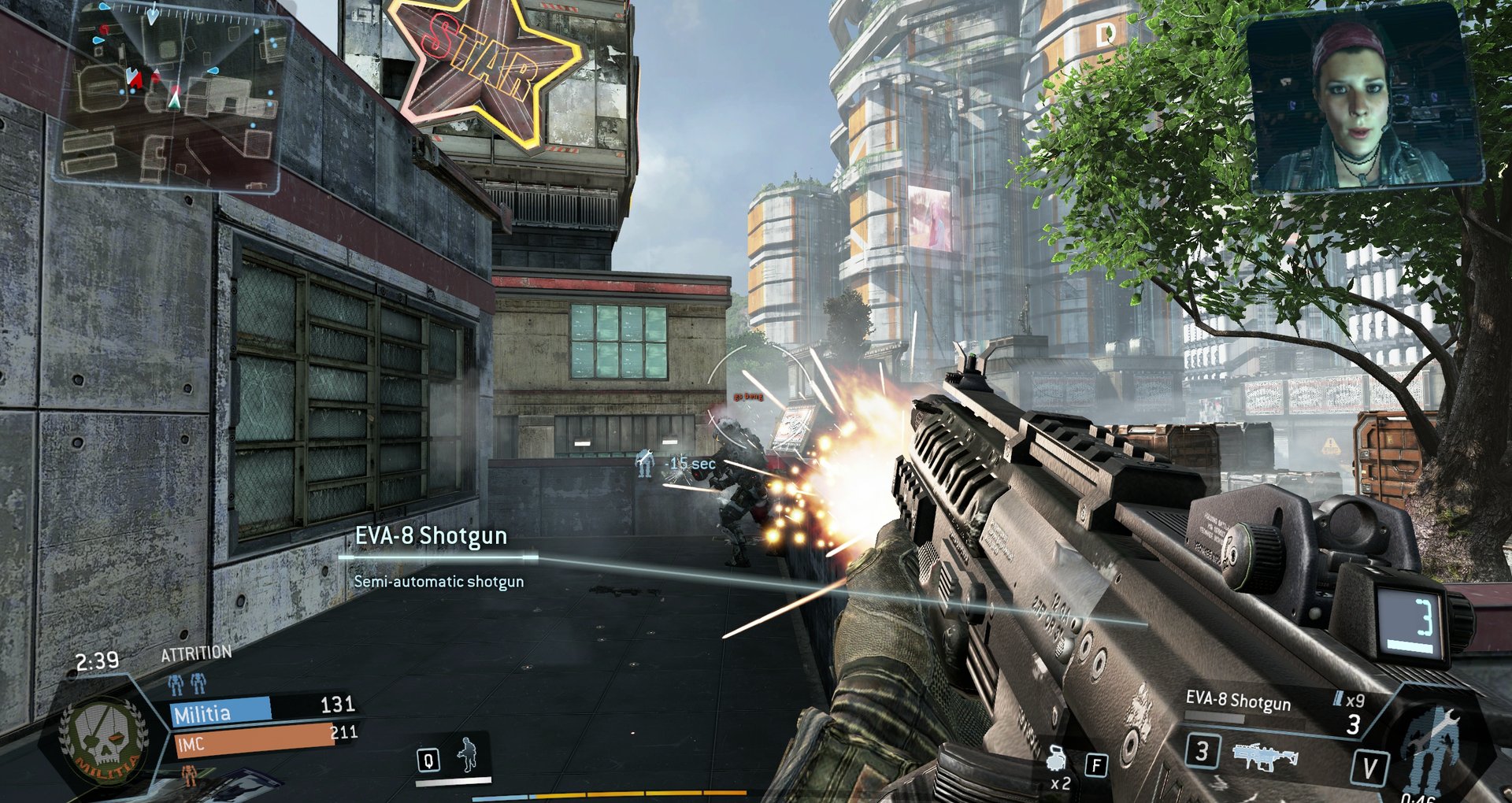
You can also tweak your experience with 'burn cards', disposable unlocks that allow you to access certain bonuses for one life only. They scale in power with rarity - the most basic allow you temporary access to weapons you haven't unlocked yet, and the most advanced grant you instant titans, reveal all enemies on your minimap, or grant you a permanent cloak when you stop shooting. Burn cards could have been a hook for some truly awful monetisation, but thankfully that's not the case. They are dished out with such frequency that after a few hours of play I never entered a match with anything less than a full set.
There are 14 maps. The majority offer a mixture of open and urban environments - the former being the preserve of titans, the latter offering cover to on-foot pilots. One map, set in a prison, links open courtyards with sweeping internal roadways at multiple levels of elevation, giving titans rare access to the game's vertical dimension. Another, a smuggling outpost, mixes complicated nests of buildings with a wide-open bay area where titans can spar with each other in the shallow water.
Almost all of the maps succeed at feeling like real places. Interiors are littered with detritus - bookshelves, upended tables, pots and pans, scattered papers - that make them look as if they have been abandoned in a hurry. Each map has a distinct palette, and there's a level of design skill evident in their buildings and backdrops that creates a feeling of occupying a piece of well-constructed, if familiar, sci-fi concept art.
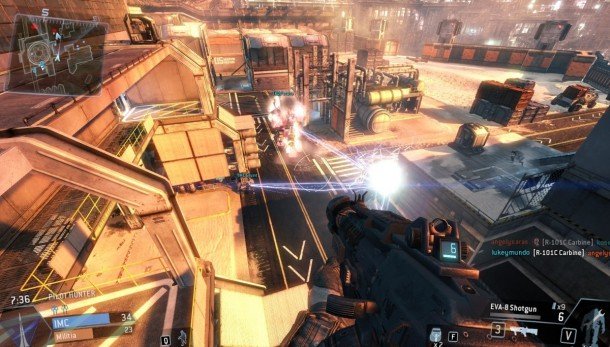
Texture quality and character detail both fall below modern standards when viewed up close, but they are compensated by unfaltering 60 frames per second at 1080p and phenomenal animation. Titanfall looks much better in motion than it does in screenshots, and again this is down to the small details. Titans in particular are more expressive and human than the mechs you might be used to. They brace against damage, lean into sprints, and dismember each other in a variety of colourful ways. Even an action as simple as reloading a chaingun is rendered with care and attention to detail.
The vast majority of your time with the game is spent in traditional multiplayer, which is divided into five modes. Minions, hackable turrets and titans are common to all five, but one of them - Last Titan Standing - is remarkable for working more like World of Tanks than regular Titanfall. Each player spawns inside their custom mech, and whichever team is able to destroy all of the enemy's titans is the winner. This turns Titanfall into a class-based vehicle game of sorts, where interactions between titan abilities become more important than they are in other modes.
Those others include Attrition, where kills against minions, titans and players are added up into an overall score for each team, and Hardpoint Domination, where teams fight over capture point scattered over the map. Capture The Flag is included without many changes to the formula, but feels considerably revitalised by Titanfall's new ideas. The weak link in the set is Pilot Hunter, a team deathmatch mode where only kills against players count towards each team's score. It's fine on paper, but in practice it's the only mode where you're really conscious of the fact that there are only six players on the enemy team. Whenever I found myself unsure about what to do, I was playing Pilot Hunter.
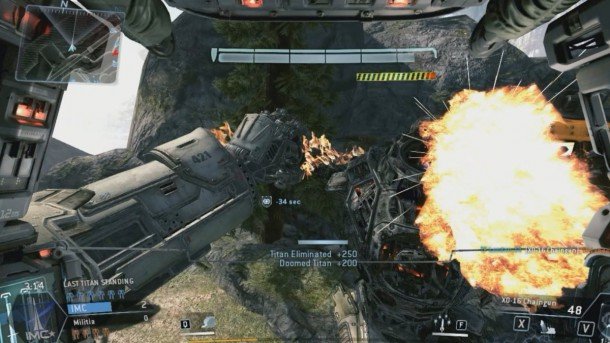
Then there's the campaign. It is, functionally, a narrative strung out across nine multiplayer missions that alternate between Hardpoint Domination and Attrition mode. Beyond narrative context provided by introductory intro and outro sequences, these missions play much like any other match.
This is not a substitute for a singleplayer campaign, but it is a novel alternative. The scale of some of these introductory sequences is impressive - one team might land in dropships while other receives a briefing underground, or warp in from a space battle in orbit, or crashland and have to storm into the map proper via its external defences. The game gets its Call of Duty-style scripted sequences, but crams them into an economical slice of time before the match proper. This is a smart refocusing of the genre onto its key strengths. That said, there are players who will miss having something to play while they're offline, and who will be frustrated by the way Titanfall casts you as an anonymous soldier in a story that is played out in voiceover by characters you're never personally involved with. It's also a shame that the campaign doesn't branch in any meaningful way based on who wins or loses.
If Titanfall had been released 15 years ago, I suspect we'd be talking about it today in the same hushed tones reserved for Tribes 2 or Team Fortress 2. This game is every bit good enough, moment-to-moment, to be a part of that legacy. Its weaknesses are not a product of its design, but its structure: where the former is characterised by admirable restraint, the latter is held back by lamentable restrictions.
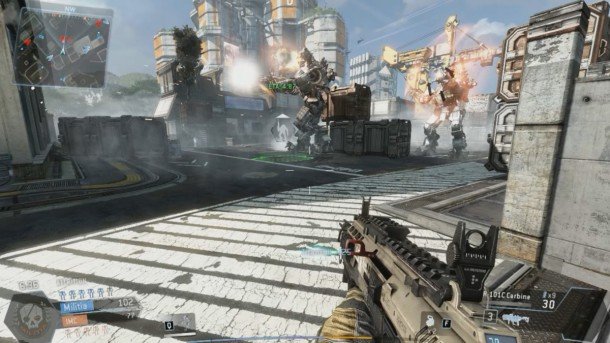
The notion of the shooter as an MMOish 'service' manifests in ugly ways. There's no LAN or offline support of any kind. You can form a party with your friends and queue for games, but you can't create your own private lobbies or dedicated servers. You can't even queue to play a specific map on a specific gamemode - you can choose to play Capture The Flag, for example, but you've got no say on where you end up doing it.
It is also extremely expensive for a modern PC game - £45/$60, plus a forthcoming £20/$25 season pass if you wish to keep up with the latest maps - and it struggles to make a claim for its long-term viability. There's no support for clans or the professional scene. There are no community features at all, really, and their absence holds the game back from attracting the hobbyist shooter crowd - the people who could ensure that the game stays lively after the buzz of launch fades. If DLC map packs divide the player base as badly as they did with Battlefield 3, I'm not sure that Titanfall will be quite the same game in six months.
This is a shame, because the things you do in Titanfall are likely to be some of the most exciting things you do in any game this year. It is clearly the work of sharp, analytical designers, and it deserves to penetrate the thick layer of cynicism that traditionally surrounds big budget shooters. I wish that this same intelligence and restraint were evident in the business culture that surrounds it.
If you choose to invest in Titanfall, make it your mission to track down the stories that emerge when all of its systems come together and sing. They are why this genre became so popular in the first place, and Titanfall is a fine way to rediscover that attraction. Just endeavour to get your money's worth while the honeymoon lasts.
The most exciting multiplayer shooter in recent years, held back from greatness by its questionable staying power.
Joining in 2011, Chris made his start with PC Gamer turning beautiful trees into magazines, first as a writer and later as deputy editor. Once PCG's reluctant MMO champion , his discovery of Dota 2 in 2012 led him to much darker, stranger places. In 2015, Chris became the editor of PC Gamer Pro, overseeing our online coverage of competitive gaming and esports. He left in 2017, and can be now found making games and recording the Crate & Crowbar podcast.
